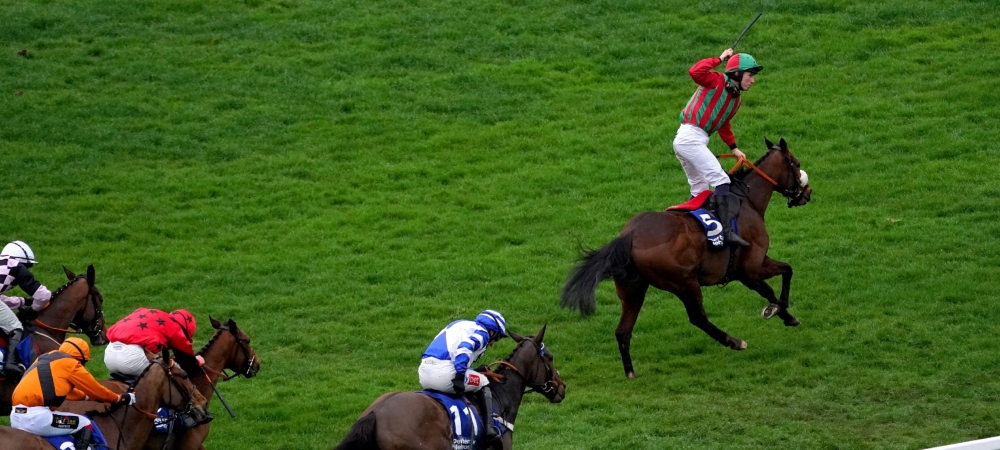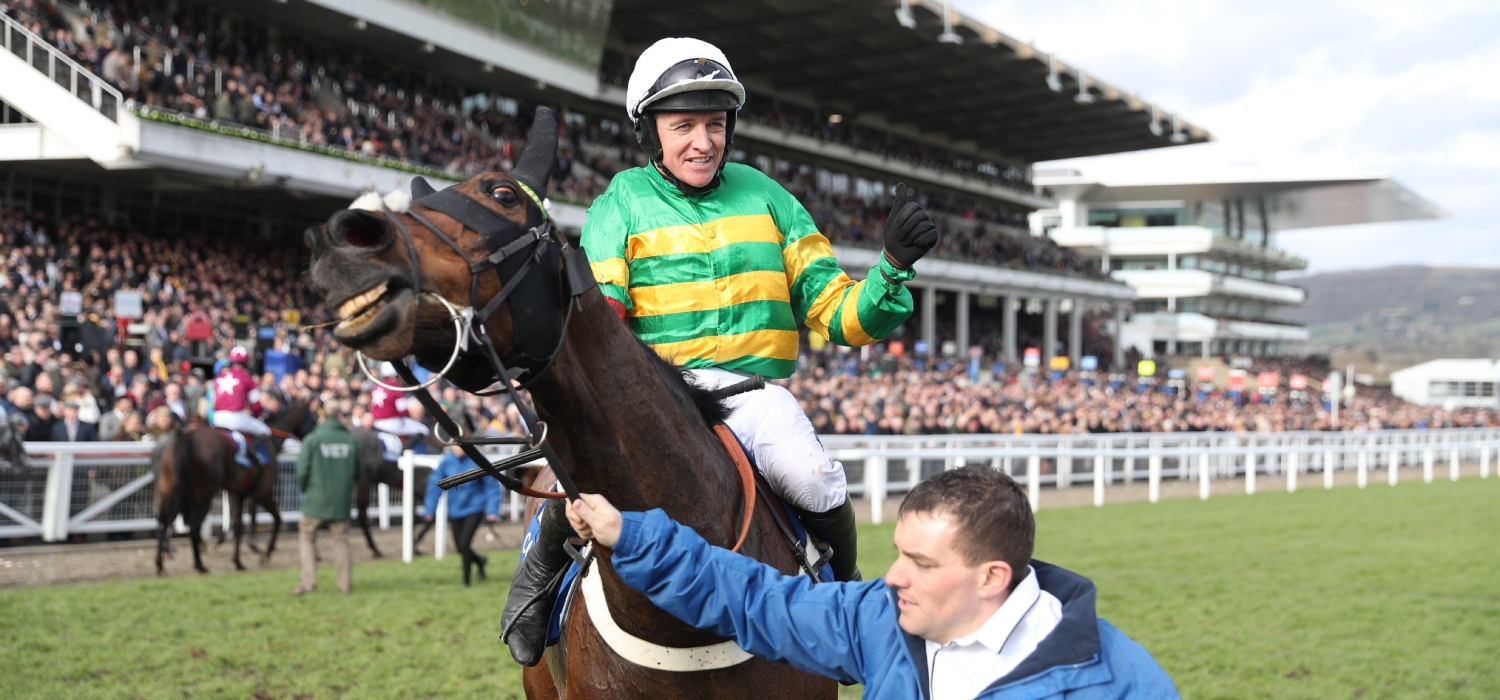
Cheltenham Trends analyst Matt Tombs is back with his third article of 2024, looking at Cheltenham Handicaps timing…
Timing is vital in betting – assessing whether a horse is likely to shorten, and if so, when, is fundamental to the art of ante-post punting. In the conditions races, horses are mainly shortening on form, confirmation of a target, etc. In the handicaps, they often shorten due to a gamble.
One thing that unites most punters is the love of a well-executed gamble. Some po-faced racing fans argue, “It’s bad for the game,” when a horse with a row of duck eggs next to their name is punted off the boards and hacks up as e.g. Son Of Flicka did when backed from 67.0 into 17.0 on the day and winning the 2012 Coral Cup.
Their outrage makes me think of Robert Shaw in The Sting after he’s lost at poker to Paul Newman. When his sidekick later says that they can’t let Newman get away with it, Shaw replies:
“What was I supposed to do? Call him for cheating better than me in front of the others?”
Everyone with a basic knowledge of racing knows lots of horses are campaigned with future handicaps in mind. The idea of singling out those who are the most adept at doing it, whilst condoning every other trainer who is doing it less efficiently makes me chuckle.
By all means, campaign for different rules. Equally, I’d like to see the stewards police the system better – e.g. not condoning classy hurdlers being 100 yards behind the leader when jumping the second in a beginner’s chase. But all the time you have handicaps, you have to accept that horses will be plotted up – and trainers will play whatever system is in place.
𝗘𝗽 𝟭𝟮: 𝗧𝗵𝗲 𝗠𝗮𝘁𝗰𝗵𝗯𝗼𝗼𝗸 𝗖𝗵𝗲𝗹𝘁𝗲𝗻𝗵𝗮𝗺 𝗧𝗿𝗮𝗶𝗹:
Special guest @CharliePoste joins Donn McClean, @thespieler and host @DanielHussey2 to chat about:
– Weekend's Racing
– Eyecatchers
– Champion Chase
– Triumph Hurdlehttps://t.co/39gWDAGNzG 🎥 pic.twitter.com/6ar2Gp8G9R— Matchbook Betting Exchange (@TeamMatchbook) February 20, 2024
If we accept that horses being plotted up and gambled on are an intrinsic part of the game – we need to know when those gambles will likely occur. My first question was whether the gambled-on horses in the Festival handicaps are typically punted before or after declarations.
From a statistical point of view, it’s much easier to look at post-declaration gambles. I started by using the prices in the Pricewise grid, which are those on the afternoon of the day before the race – and compared them to SP.
Moving a shorter-priced horse significantly takes more money – even at the Festival, a 100.0 shot doesn’t take too much money to shorten it. So what constitutes a “proper gamble”? I’ve drawn an arbitrary line to define a proper gamble as being where the horse’s price has shortened such that the implied chances of winning have:
- At least doubled if it goes off a double-figure price
- Increased by more than 50% if it goes off a single-figure price
(Horses that became non-runners after being in the Pricewise grid complicate matters – I’ve adjusted prices purely mathematically to see whether the gambles qualify under the criteria above.)
In the last 5 years there have been 64 handicap runners that qualify as being ‘gambles’ in those last c24 hours. Only 6 won, and if you’d backed them all, even if you’d got the best price on the Pricewise grid, you’d have lost 22% of your stakes.
To do that, you’d need to be able to predict which horses would be the subject of the gambles. If by contrast, you’d waited to see the gambles and backed them at SP you’d have lost 56% of your stakes.
Even those able to get on the gambles as they develop have done only pretty much what you’d expect for backing all runners (adjusting for the over-round.) Those that have followed the gambles after they’ve gathered momentum and the prices shortened have done worse than you’d expect backing the average horse in a race.
Those gambles in the last 24 hours haven’t paid dividends.

It’s also notable that the number of ‘last 24 hours’ gambles and the success of them have declined. Over those 5 Festivals those 64 gambles were split (most recent last): 17-12-16-11-8. 3 of the 6 wins came in 2019, 1 in 2020 and 2 in 2021 with none in either of the last 2 years.
Looking at the actual winners of those 9 handicaps for each of the 5 years, the average reduction in price each year, (again most recent last,) has been: 42%-35%-18%-19%-11%. Given the over-round is generally higher at SP, at the last 3 Festivals, the winners have, on average, effectively been almost static in the market during the last 24 hours.
These are small samples and I’ve used arbitrary lines so I wouldn’t be concluding that successful on-the-day punts in the handicaps are a thing of the past.
What it does suggest, though, is that rather than wait for the declarations, as happened in the past, a higher proportion of punters are now trying to get the value in the handicaps before then. The glut of Festival previews and the power of social media are spreading information and vibes more quickly.
That makes sense to me and I think that if we want to get the value by backing the successfully gambled on handicappers at juicy prices – we’ll generally need to do it in the previous couple of weeks, not post-declaration.
It therefore makes sense to do your handicap analysis when the entries/weights come out. The BHA’s reassessment of the Irish horses is so fundamental to the Festival handicaps that most of my betting is done once I’ve seen those marks. The entries close on 20th February and the weights are due for publication on the 27th – i.e. 14 days before the Festival begins.
We can’t know which handicaps will produce successful gambles this year, but we can look at how predictable they’ve been. Gambles into short prices are less likely to be successful in the more unpredictable handicaps.
I therefore divide the 9 handicaps into 3 categories.
The first category just has the Ultima in it. That’s because the best handicapped Irish staying chasers tend to go for the Kim Muir where the crack Qualified Riders are such an advantage.
The Ultima is the only Festival handicap dominated by British trained horses – the last Irish trained winner was in 2006. It is just about the most predictable of the Festival handicaps these days – 18 of the 23 winners this century, including 9 of the last 10, coming from the first 5 in the SP market. It is therefore a good race for ante-post punting, with the winners often shortening significantly in towards the front of the market.
As we have the marks of the British horses, it can make sense to bet ante-post on the Ultima before the weights are published – i.e. try to find the horses that will shorten a lot before the gamble starts. I’m most likely to do that when the entries are published. However, if I know a British horse is being aimed at the Ultima and won’t run again beforehand, then I might consider a bet before the publication of the entries.
Last year Corach Rambler was 17.0 in early-February, 7.5 in the Pricewise grid before winning at 7.0, (he hadn’t run since November so wasn’t shortening due to improved form.) There was plenty of value to be had by going in ante-post.
The second category is what I’d term the more predictable of the other 8 handicaps. That’s the Pertemps, Kim Muir & Martin Pipe, (arguably the Plate should now be in this category). In 2009, the Martin Pipe was introduced, and the Kim Muir switched to the New Course.
In the 15 renewals of those 3 handicaps since, the winner has come from the front 6 in the SP market:
- 10 times in the Martin Pipe
- 11 times in the Pertemps
- 12 times in the Kim Muir
Those 3 handicaps have increasingly been dominated by Irish stables, who have won 11 of the 15 renewals in the last 5 years. It’s therefore vital to see the weights but with plenty of the winners shortening into the front end of the market, the aftermath of the publication of the weights can be the sweet spot to bet on them.
The Kim Muir is different to the other 2 in that when the news breaks about which horses the crack Qualified Riders will be on has a big impact on the market – and the likely result. More flexibility on timing is often needed.
The third category is the 5 more unpredictable handicaps – the Fred Winter, Coral Cup, Grand Annual, Plate and County.
By way of illustration, the average winning SP in the last 15 renewals of the 4 ‘predictable’ handicaps has been
- Ultima = 13.6
- Pertemps = 14.0
- Kim Muir = 13.8
- Martin Pipe = 13.8
But in the same period the 5 ‘unpredictable’ handicaps the average winning SP has been:
- Fred Winter = 23.6
- Coral Cup = 20.3
- Grand Annual = 20.8
- Plate = 18.5
- County = 18.6
That doesn’t mean successful gambles won’t happen in those 5 handicaps. Chosen Mate in the Grand Annual and Band Of Outlaws in the Fred Winter were big gambles into favouritism.
With so many shocks in those races, I often look for value at bigger prices. The long shots tend to be defensively priced ante-post and are often a bigger price post-declaration, sometimes biggest at SP. My starting assumption is that I’ll wait until post-declaration to bet on these races – but I’ll be doing my analysis when the weights come out.
Each handicap is different, as is each renewal – what I’ve set out isn’t a rigid rule I use. It’s long odds-on I’ll have a bet in at least 1 of those 5 unpredictable handicaps before declarations. But it’s worth thinking about the nature of the race, especially how predictable it is – and use that as a starting point for when the sweet spot for betting in that handicap is most likely to be.
That approach hopefully provides us with the best chance to have analysed and be betting on the handicaps just as successful gambles are beginning. Good luck!








